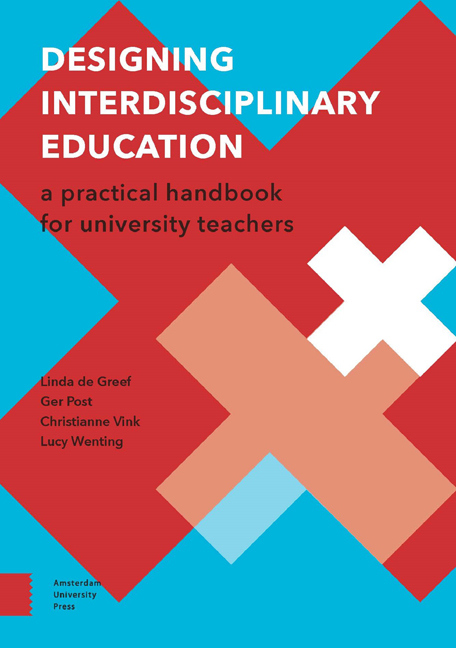Book contents
- Frontmatter
- Contents
- Acknowledgements
- 1 Introduction
- 2 An Overview of the Development Stages
- 3 Unravelling Interdisciplinary Understanding
- 4 Developing the Raw Sketch
- 5 Formulating Interdisciplinary Learning Outcomes
- 6 Embedding Integration in the Programme Design
- 7 Hiring and Engaging Faculty
- 8 Exploring the Teaching Philosophy and Didactic Methods
- 9 Assessment of Interdisciplinary Learning Outcomes
- 10 Interdisciplinary Teaching in Practice
- 11 Programme Assessment and Adjustment
- Appendices
- References
- Colophon
8 - Exploring the Teaching Philosophy and Didactic Methods
- Frontmatter
- Contents
- Acknowledgements
- 1 Introduction
- 2 An Overview of the Development Stages
- 3 Unravelling Interdisciplinary Understanding
- 4 Developing the Raw Sketch
- 5 Formulating Interdisciplinary Learning Outcomes
- 6 Embedding Integration in the Programme Design
- 7 Hiring and Engaging Faculty
- 8 Exploring the Teaching Philosophy and Didactic Methods
- 9 Assessment of Interdisciplinary Learning Outcomes
- 10 Interdisciplinary Teaching in Practice
- 11 Programme Assessment and Adjustment
- Appendices
- References
- Colophon
Summary
‘It is important that students bring a certain ragamuffin, barefoot irreverence to their studies; they are not here to worship what is known, but to question it.’
Jacob Bronowski
The fact that different ideas exist on the definition of learning – not only scientifically but also among teachers and students – is important to consider when choosing a specific teaching philosophy. This chapter addresses the assumptions that students and teachers have on topics such as learning and understanding. When deciding on a teaching philosophy, it is helpful to take into account these often implicit assumptions because they impact how successful a certain pedagogical approach will be with a specific group of students. Practicalities surrounding the formulation of a shared teaching philosophy will be outlined and illustrated with examples. At the end of this chapter, the most commonly used didactic methods that nurture interdisciplinary understanding will be discussed.
Assumptions of teaching and understanding
What does it mean to ‘know’ something? When have you truly ‘learned’ something new? Although many of us use the same words (such as learning, knowledge, understanding and mastery), we often have different definitions of those terms. In this section, we discuss why interdisciplinary education requires teachers to have elaborate epistemological assumptions on learning and understanding (at least level 4 in the taxonomy of Van Rossum and Hamer, as described below) as well as the capacity to instil these elaborate assumptions in their students.
Research has shown that students and teachers may differ in their assumptions of the concepts of learning, knowing, understanding and mastering. For instance, Van Rossum and Hamer interviewed 170 students about what they mean when they say they understand something (Van Rossum & Hamer, 2010). Their research showed that many students think they understand something when they can reproduce the information on an exam. Teachers, on the other hand, often look for something different. When a teacher asks students whether they understand the study material, the teacher is likely inquiring whether the student can illustrate an argument with new examples or illustrations. The teacher may hope students see associations between the newly discussed material and their previous knowledge or are able to use the new information to solve a problem.
- Type
- Chapter
- Information
- Designing Interdisciplinary EducationA Practical Handbook for University Teachers, pp. 104 - 120Publisher: Amsterdam University PressPrint publication year: 2017



